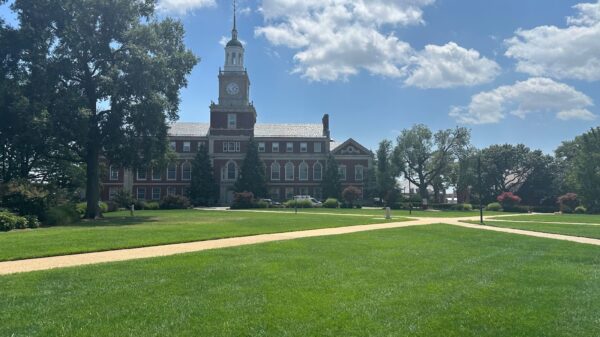For almost 20 years, the landscape of college football has been stable. The nation consisted of five major conferences called the Power Five conferences: the Big Ten, the Atlantic Coast Conference (ACC), the Pac-12, the Big 12, and the Southeastern Conference (SEC).
The Power Five and other conferences provided balance and organization. Now, that has changed drastically as numerous schools have switched conferences to switch up the landscape of college football completely.
Entering the 2023 season, over 13 teams have relocated to a new conference, mainly outside the Power Five. The only Power Five conference that saw a switch this year was the Big 12 as they added Brigham Young University, the University of Cincinnati, the University of Houston and the University of Central Florida. However, in 2024, 14 schools will be switching conferences, mainly within the Power Five.
When this occurs next year, the Pac-12 will have lost essentially every school, as ten of the 12 teams will be in a different conference. The Big Ten will welcome Oregon, Washington, UCLA, and USC next year, all teams from the Pac-12. The Big Ten will become the most prominent conference when the move is official, giving them 18 teams total.
This tremendous move will have unspeakable effects on college football. Now, teams are scattered all over the country, leaving the future of conferences like the Pac-12 uncertain and making the Big Ten and SEC into superconferences. With all the commotion and movement happening, one of the biggest questions is the motivation behind this seismic shift.
Money is the main factor that runs the NCAA landscape right now. With the name, image, and likeness (NIL) rules in place, players and schools are making more money than before, clearing the way for more sponsorships and brand endorsements. As for the schools, one of the largest sources of income is TV deals.
Each conference has its unique TV deal with different networks and streaming services that can generate plenty of revenue for schools. The Big Ten has the highest TV deal, as they are in the first year of their new seven-year, $7 billion deal with NBC, FOX, and CBS.
All conference teams will earn $80-$100 million per year for the entirety of the contract. Some conferences are adapting to the changing TV landscape, as the Big Ten will have games aired on Peacock, and the SEC will have games streamed to ESPN+ when their new deal with Disney kicks in next year.
The biggest reason behind the numerous exits from the Pac-12 is that they’re the only Power Five conference that has yet to negotiate a new TV deal. The current ESPN and FOX deal expires at the end of the current season, and the proposed solution was a deal with Apple TV that would generate $23 million a year. It also included increased pay based on possible subscriptions to a Pac-12 athletic package on the service.
Most of the presidents from the Pac-12 schools declined, as they wanted consistent, national coverage for the school and players.
With no new media deal and the lack of teams in the conference, the once-famed Pac-12 may no longer be around. With this much movement at the Football Bowl Subdivision (FBS) level, the highest level of college football, the impact on HBCUs concerns many.
A popular HBCU is familiar with realignment, as North Carolina A&T (NCAT) has relocated twice since 2021. NCAT had been a part of the Mid-East Athletic Conference (MEAC) for a long time, having dominated and won four Celebration Bowls since the title game was founded in 2015. With all the built-up success, NCAT surprised the conference as they decided to switch from the MEAC to the Big South in 2021.
After a year in the Big South, the school decided to switch again by joining the Colonial Athletic Association (CAA), regarded as one of the best conferences at the Football Championship Subdivision (FCS) level. The football team remained a part of the Big South for one more year before switching to the CAA in 2023 with the rest of the school’s athletics.
When asked about the reason behind the decisions, Earl Hilton III, NCAT’s athletic director, stated that the school was “…attempting institutionally to do what we feel like is in the best interest of our student-athletes, from a competitive, from a perspicacious, from an academic perspective.”
He then said these decisions are “…always with the idea of what’s in the best interest for our student-athletes. Experience, competition, and academics, that’s how we roll it out.”
With NCAT already making a prominent realignment decision and the barrage of moves at the FBS level, many wonder what the future looks like for HBCU football.
Hilton offered his insight on the future, saying, “None of us are going to be immune…What we see happening up here with the Power Fives will trickle down. It will move through all of FBS football, and then into FCS football, and likely will reverberate even into Division II and Division III by the time it’s all said and done.”
Hilton also mentioned that consolidation and even having some conferences disappear wouldn’t surprise him. He questioned the future of the Pac-12, asking, “Are they going to disappear, or are they going to reformulate themselves and pull institutions in from other conferences who are in conferences right now?”
The FCS has already experienced realignment, as 130 FCS teams will be in a new conference. Some schools went to the next level, James Madison University, Jacksonville State University, Sam Houston University, and Kennesaw State University, all will switch to the FBS level between now and 2024.
With so much movement happening at the FCS level, the MEAC and Southwestern Athletic Conference (SWAC) could be gone and likely join the FBS. The MEAC currently has six teams that do not compete in the FCS playoffs. If the Pac-12 wishes to remain alive, it could attract HBCUs and other FCS-level schools. This would also provide HBCUs more national coverage and the chance to generate substantial revenue with the NIL laws and TV deals.
With college football experiencing a move of this magnitude at the higher and lower levels, the new realignment could pave the way for HBCUs to find their way to a bigger spotlight.
Copy edited by Diamond Hamm









